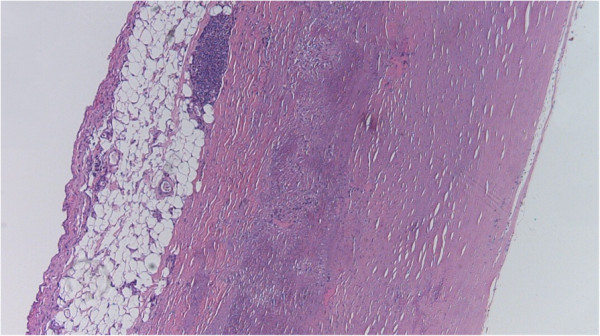Playlist
Show Playlist
Hide Playlist
Introduction to Ischemia and Infarct
-
Slides Complications of Atherosclerosis.pdf
-
Reference List Pathology.pdf
-
Download Lecture Overview
00:01 So welcome. 00:02 This is the final chapter in a number of the sessions we've been doing on atherosclerosis, and then the complications of atherosclerosis, And ischemia and infarction are very important in terms of the total pathology, and causes of death and morbidity, mortality in the human population. 00:20 So let's get going. 00:22 Here's the roadmap, we've been all the way through kind of big concepts: risk factors, the pathogenesis of how plaques form, what plaques look like, and some of their immediate complications, approaches to diagnosis and treatment. 00:36 And finally, now, complications. 00:41 So terms, first up, ischemia. 00:44 Ischemia is literally just an inadequate blood flow to maintain tissue function. 00:51 And that can be somewhat variable. 00:53 So it's not just there's a fixed amount of demand, because the heart for example, when it's beating faster, or has to generate more blood pressure, has a greater demand, there's more work being done. 01:06 So things that may not be ischemic, flow that may not be ischemic at rest, can become limiting when you increase demand, so it's a supply-demand issue. 01:19 But the important point about ischema, the really important point is that the tissue is still alive, it may not be functioning appropriately. 01:27 But it's still there and we can bring it back. 01:31 As opposed to the next step, infarction. 01:33 And this is inadequate perfusion, blood supply to maintain viability. 01:39 The tissue dies, simply. 01:43 So tissue requirements too are not only dependent on the baseline metabolism, the demand of the tissue and the activity demands. 01:51 But it is also going to depend on the type of tissue as we will see shortly. 01:58 Important point in that red box as well in the parentheses is that the activity demands can also be modified. 02:04 So we can do extended periods of time of cardiac surgery, the heart is not being perfused simply by cooling the heart, and by stopping the heart. 02:15 And when that happens, the demands, the ATP requirements to generate energy go way, way, way down. 02:22 So that allows the very competent cardiac surgeon to be able to do what she needs to do in a couple hours, even though the heart is not actually being perfused. 02:32 Okay, so what are the different tissue demands? So there are some very high sensitivity tissues, neurons in particular, need to have a continuous blood supply, bringing them oxygen, and nutrition. 02:47 And if they're cut off, even a short period of time, 3-5 minutes, as you see there, they will die. 02:55 That's a really important point because if the heart quits beating, the rest of you is doing okay, it's not yet dead, but the neurons in your brain will shut down permanently within a few minutes. 03:06 That's why we have to get in there and do CPR immediately if someone has a rhythmic stoppage of cardiac motion. 03:15 Okay, next, sensitivity. 03:18 Cardiac myocytes and they are moderately sensitive. 03:23 they will not die until about 20 to 30 minutes after we've cut off their blood supply. 03:28 Importantly, though, as we'll talk about in the next slide, they won't function. 03:34 squeeze, if we cut off their blood supply for even a couple of minutes. 03:38 So there's a difference between also function and viability. 03:43 Tissues that are moderately sensitive, hepatocytes and renal tubular epithelial cells, for example, and there are others within the body are moderately sensitive, so we don't, they won't die even though we cut off the blood supply for a couple hours. 03:57 And then there are a lot of tissues that are reasonably low sensitivity, have reasonably low sensitivity. 04:04 In other words, don't have a high intrinsic metabolic rate: skin epithelium, fibroblasts, skeletal muscle. 04:12 So that means that actually, for the orthopedic surgeons in the audience, you can put a tourniquet around the leg, have no blood flow into a joint so you can do your orthopedic surgery. 04:24 Take off that tourniquet. Three hours later, the leg is absolutely fine. 04:28 If I do the same thing to a cerebral circulation in three minutes, the patient is dead and in the heart, you got about a half hour.
About the Lecture
The lecture Introduction to Ischemia and Infarct by Richard Mitchell, MD, PhD is from the course Atherosclerosis.
Included Quiz Questions
How long can hepatocytes survive after the loss of perfusion?
- 1 to 3 hours
- 3 to 5 minutes
- 10 to 12 hours
- 20 to 30 minutes
- 6 to 8 hours
When does the microvascular injury of the heart start to occur due to loss of perfusion?
- Within 20-30 minutes
- Within seconds
- In 30 to 40 minutes
- In 5 to 10 minutes
- After 4 hours
Customer reviews
5,0 of 5 stars
| 5 Stars |
|
5 |
| 4 Stars |
|
0 |
| 3 Stars |
|
0 |
| 2 Stars |
|
0 |
| 1 Star |
|
0 |




